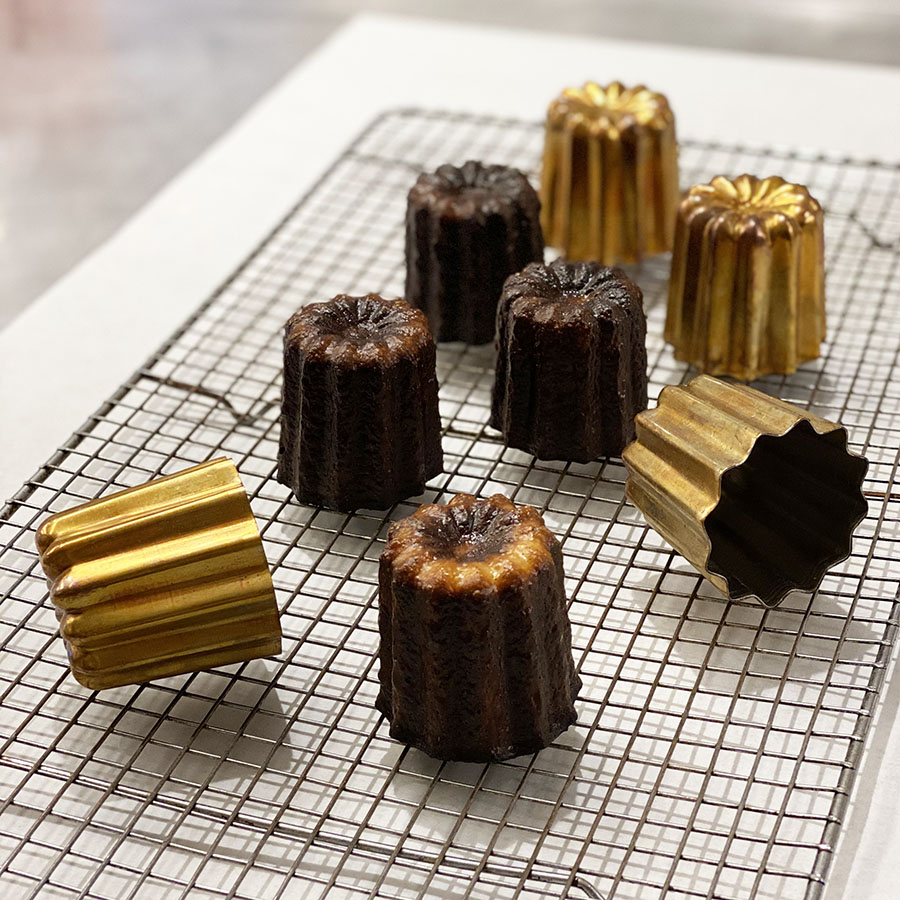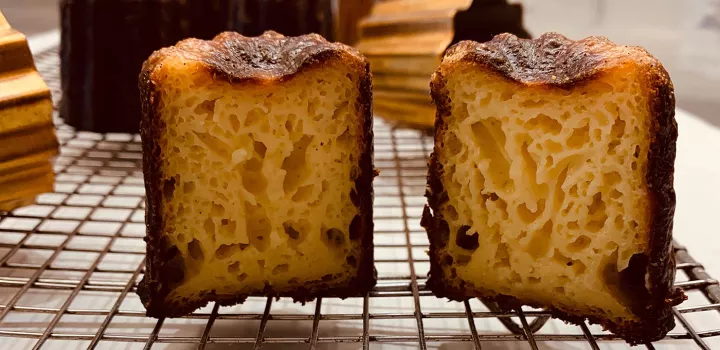The Canelé: A Journey Through Culinary History and Technique
Related Articles
- The Majestic Mille-Feuille: A Journey Through Layers Of Flavor And Technique
- A Journey Through The World Of Quiche: From Humble Beginnings To Modern Masterpieces
- A Journey Through Time: Unveiling The Secrets Of Pastitsio
- A Dive Into The Decadent World Of Eggs Benedict: History, Recipes, And Tips For Perfection
- A Journey Through Flavor: Exploring The World Of Pasta Pesto (Italia)
Introduction
Discover everything you need to know about The Canelé: A Journey Through Culinary History and Technique
The Canelé: A Journey Through Culinary History and Technique

The canelé, a small, cylindrical pastry hailing from Bordeaux, France, is a testament to the enduring power of tradition and the exquisite artistry of pastry-making. These little delights, with their caramelized crust and custardy interior, have captivated palates for centuries, their allure stemming from a perfect marriage of textures and flavors. But the canelé is more than just a dessert; it’s a story, a journey through time, and a window into the evolution of culinary techniques.
A Glimpse into History: From Humble Origins to Culinary Icon
The canelé’s history is deeply intertwined with the city of Bordeaux, its origins shrouded in the mists of time. While its exact birthplace remains a subject of debate, most culinary historians agree that the canelé emerged in the 18th century, likely in the convents of Bordeaux.
The pastry’s name, "canelé," is believed to derive from the Latin word "canaliculus," meaning "little groove." This aptly describes the characteristic ridges that adorn the canelé’s exterior, a result of the traditional copper molds used in its baking.
Early canelé recipes were simple, often relying on a basic batter of flour, eggs, milk, and sugar. The distinctive caramelized crust was achieved through the use of molds coated with a mixture of beeswax and olive oil, a technique that imparted both a unique flavor and the characteristic dark brown hue.
Over time, the canelé’s recipe evolved, incorporating ingredients like rum, vanilla, and even a touch of brandy. These additions enhanced the pastry’s flavor profile, adding complexity and depth to its already rich character.
The Art of Canelé Making: A Symphony of Ingredients and Techniques
Crafting the perfect canelé is a delicate dance of precision and patience. The recipe, though seemingly simple, demands meticulous attention to detail, from the careful selection of ingredients to the precise execution of techniques.
1. The Foundation: Ingredients and Their Roles
- Flour: The foundation of the canelé, flour provides structure and texture. While all-purpose flour is commonly used, some bakers prefer using a combination of all-purpose and cake flour for a slightly lighter texture.
- Eggs: Eggs contribute to the canelé’s richness, creaminess, and its ability to rise. They also act as a binder, holding the batter together.
- Milk: Milk adds moisture and contributes to the custardy texture. Whole milk is preferred for its richness, but low-fat or even plant-based alternatives can be used.
- Sugar: Sugar provides sweetness and helps to caramelize the crust. Granulated sugar is the most common choice, but brown sugar can be used for a slightly more complex flavor.
- Vanilla: Vanilla extract adds a warm, aromatic touch, enhancing the canelé’s overall flavor profile.
- Rum: Rum, a traditional ingredient, adds a subtle boozy note and enhances the pastry’s complexity.
- Butter: Butter, while not a core ingredient, can be added for a richer flavor and texture.

2. The Ritual: Mastering the Techniques
- The Batter: The key to a successful canelé lies in the batter’s consistency. It should be smooth, thick, and slightly runny. Achieving this requires careful mixing and resting.
- The Molds: Traditionally, canelé molds are made of copper, which helps to evenly distribute heat and create the characteristic caramelized crust. However, silicone molds can be used as a more affordable alternative.
- The Caramelization: The caramelized crust is a defining feature of the canelé. This is achieved by coating the molds with a mixture of beeswax and olive oil or a simple sugar syrup. The sugar caramelizes during baking, creating the iconic crust.
- The Baking Process: Canelés are baked at a high temperature, which helps to set the custard quickly and achieve a crisp crust. The baking time can vary depending on the size of the molds and the oven used.

Variations and Innovations: Beyond the Traditional
While the classic canelé recipe is a timeless masterpiece, culinary creativity knows no bounds. Bakers have explored countless variations, incorporating different flavors and textures to create unique and exciting twists on this beloved pastry.
1. Flavor Explorations: A World of Possibilities
- Citrus Infusion: Lemon, orange, and grapefruit zest can be added to the batter, adding a bright, citrusy note.
- Chocolate Indulgence: Cocoa powder or melted chocolate can be incorporated for a decadent chocolate canelé.
- Spiced Delights: Cinnamon, nutmeg, cardamom, and other spices can be used to create warm and aromatic variations.
- Fruity Delights: Fruit purees, like raspberry or blueberry, can be added to the batter for a sweet and tangy flavor.
- Alcohol Infusions: A splash of brandy, bourbon, or even liqueurs like amaretto or Grand Marnier can enhance the canelé’s flavor complexity.
2. Textural Adventures: Pushing the Boundaries
- Choux Pastry Canelé: Choux pastry can be used as a base, creating a light and airy canelé with a contrasting texture.
- Canelé with a Crunch: Toasted nuts, crunchy granola, or even a crumble topping can add a textural contrast to the smooth, custardy interior.
- Canelé Cheesecake: A cheesecake filling can be incorporated, creating a decadent and indulgent hybrid dessert.
Culinary Tips for Canelé Perfection: Mastering the Art of Baking
- Temperature Control: Baking at the correct temperature is crucial for achieving a perfect canelé. Preheat your oven thoroughly and maintain a consistent temperature throughout the baking process.
- Mold Preparation: Ensure the molds are thoroughly greased and dusted with sugar or a beeswax and olive oil mixture to prevent sticking and achieve the signature caramelized crust.
- Batter Consistency: The batter should be thick and slightly runny. If it’s too thin, it will spread too much in the molds. If it’s too thick, it won’t rise properly.
- Resting Time: Allow the batter to rest for at least 30 minutes before baking. This will allow the gluten to relax, resulting in a more tender and flavorful canelé.
- Baking Time: The baking time will vary depending on the size of the molds and the oven used. Start checking for doneness after 30 minutes, and continue baking until the canelés are golden brown and firm to the touch.
- Cooling Time: Allow the canelés to cool completely in the molds before serving. This will help them to set properly and prevent them from collapsing.
Serving and Enjoying the Canelé: A Culinary Celebration
Canelés are best enjoyed fresh, but they can be stored in an airtight container at room temperature for up to two days. For a richer flavor, they can be warmed gently before serving.
- Simple Delights: Canelés can be enjoyed on their own, their rich and custardy flavors needing no embellishment.
- Sweet Pairings: Serve them with a dollop of whipped cream, a drizzle of chocolate sauce, or a sprinkle of powdered sugar.
- Coffee Companion: Canelés are a perfect pairing for a cup of coffee or tea, their sweetness complementing the bitterness of the beverage.
- Dessert Course: Canelés can be incorporated into a dessert course, alongside other pastries or fruit.
The Canelé: A Legacy of Culinary Excellence
The canelé, with its simple yet elegant design and its complex symphony of flavors and textures, stands as a testament to the enduring power of culinary tradition. It is a testament to the artistry of pastry-making, a celebration of the meticulous techniques and the creative spirit that drives culinary innovation.
From its humble origins in the convents of Bordeaux to its status as a culinary icon, the canelé continues to enchant palates and inspire bakers around the world. It is a reminder that even the simplest of ingredients can be transformed into a masterpiece, a testament to the magic of culinary creativity.
Closure
Thank you for reading! Stay with us for more insights on The Canelé: A Journey Through Culinary History and Technique.
Make sure to follow us for more exciting news and reviews.
Feel free to share your experience with The Canelé: A Journey Through Culinary History and Technique in the comment section.
Keep visiting our website for the latest trends and reviews.






